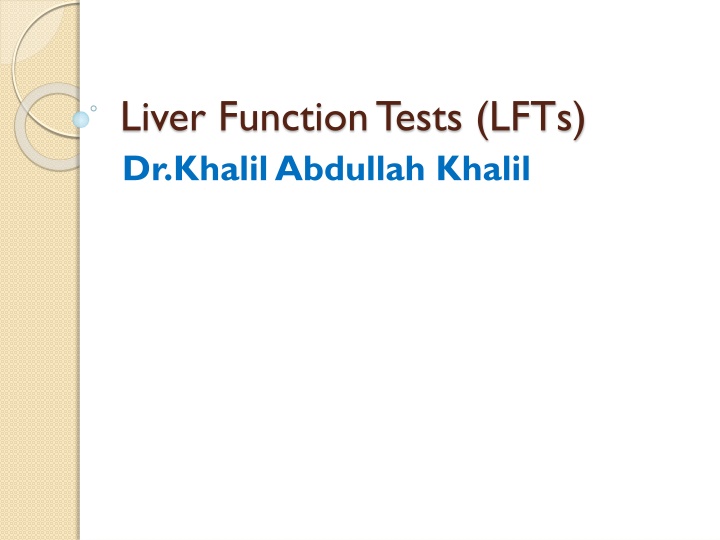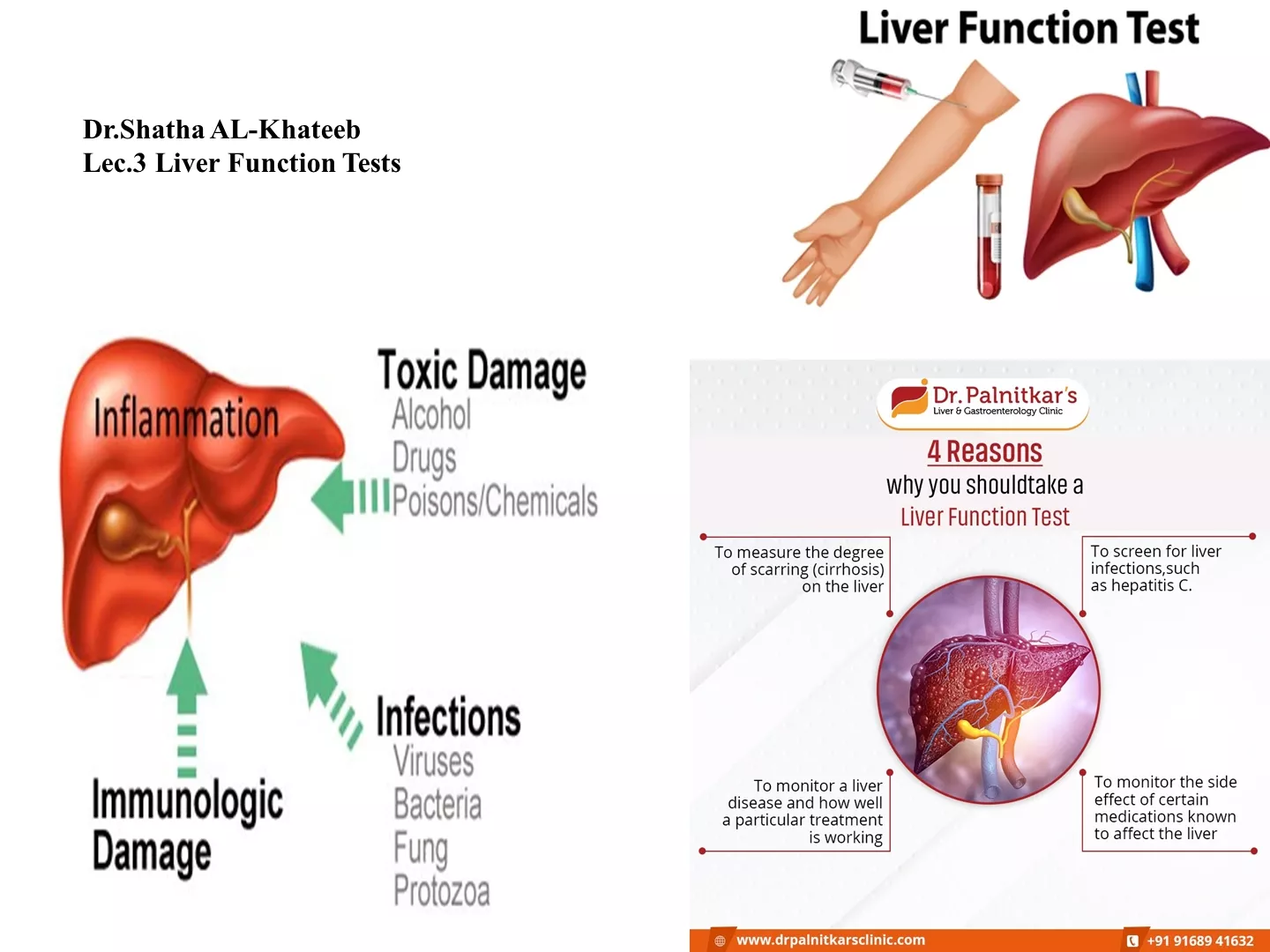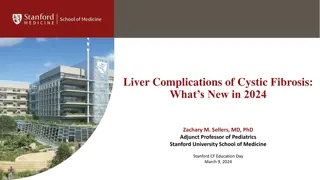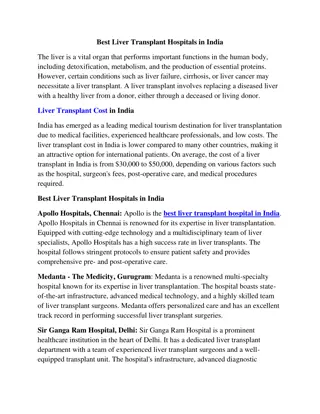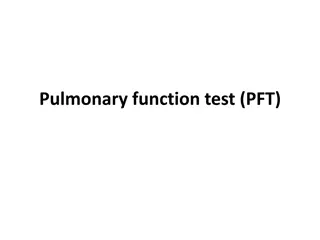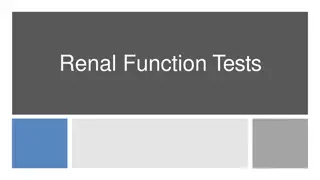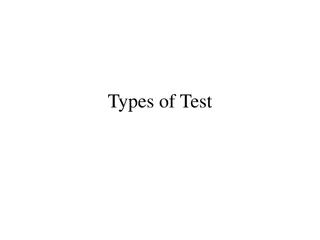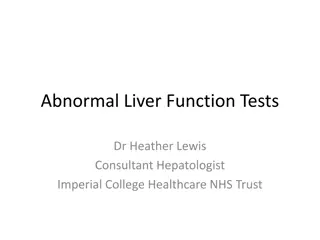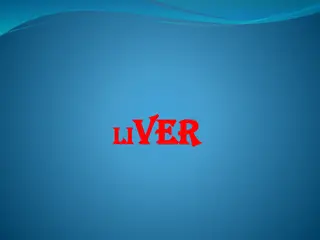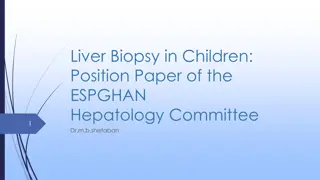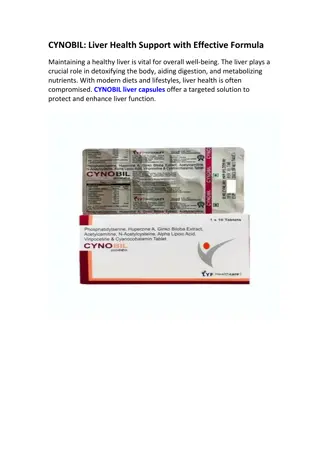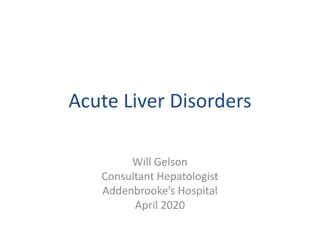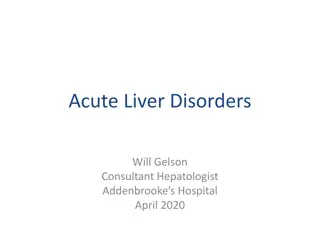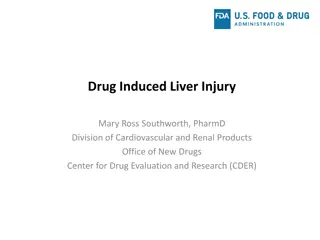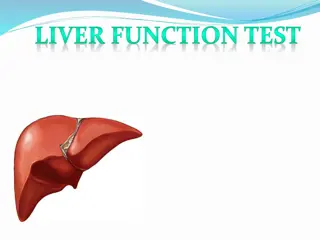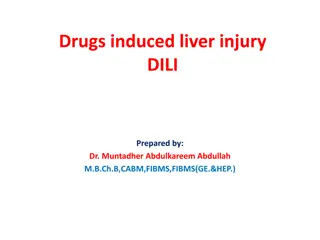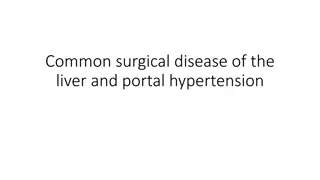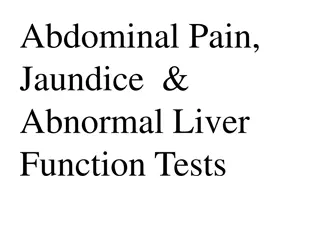Liver Function Tests (LFTs) by Dr. Khalil Abdullah: Understanding Liver Health
The liver, located in the upper right abdomen, plays vital roles like storing glycogen, processing fats and proteins, and detoxifying the body. Liver Function Tests (LFTs) are essential clinical biochemistry laboratory assays to assess liver health, diagnose liver disease, and monitor its progression. Alanine Aminotransferase (ALT) and Aspartate Aminotransferase (AST) are enzymes that indicate liver cell damage, while Alkaline Phosphatase (ALP) is linked to the biliary tract. These tests help evaluate liver function, identify liver disorders, and guide medical interventions effectively.
Download Presentation

Please find below an Image/Link to download the presentation.
The content on the website is provided AS IS for your information and personal use only. It may not be sold, licensed, or shared on other websites without obtaining consent from the author.If you encounter any issues during the download, it is possible that the publisher has removed the file from their server.
You are allowed to download the files provided on this website for personal or commercial use, subject to the condition that they are used lawfully. All files are the property of their respective owners.
The content on the website is provided AS IS for your information and personal use only. It may not be sold, licensed, or shared on other websites without obtaining consent from the author.
E N D
Presentation Transcript
Liver Function Tests (LFTs) Dr.Khalil Abdullah Khalil
The liver is in the upper right part of the abdomen. The functions of the liver include: 1-storing glycogen (fuel for the body) which is made from sugars. 2-helping to process fats and proteins from digested food. 3-making proteins that are essential for blood to clot (clotting factors). 4-processing many medicines which you may take. 5- helping to remove poisons and toxins from the body.
Liver function tests: -LFTs are group of clinical biochemistry laboratory blood assays designed to give information about the state of a patient s liver. -As the liver performs it's various functions it makes a number of chemicals that pass into the bloodstream and bile. Various liver disorders alter the blood level of these chemicals. Some of these chemicals can be measured in a blood sample. Some tests that are commonly done on a blood sample are called 'LFTs' (liver function tests).
Liver function tests can be classified as: a. Tests of excretion by the liver. b. Evaluation of synthesis in liver. c. Evaluation of enzyme activity. Liver function tests are most often employed to determine: i. The presence of liver disease. ii. The type of liver disease. iii. The extent and progression of liver disease. Note: The diagnosis of liver disease depends upon a complete history, complete physical examination, and evaluation of liver function tests and further invasive and noninvasive tests. These usually measure the following
AlanineAminotransferase (ALT)=SGPT: -ALT is the enzyme produced within the cells of the liver. The level of ALT abnormality is increased in conditions where cells of the liver have been inflamed or undergone cell death. As the cells are damaged, the ALT leaks into the bloodstream leading to a rise in the serum levels. Any form of hepatic cell damage can result in an elevation in the ALT. ALT is the most sensitive marker for liver cell damage. Clinical applications of ALT assays are confined mainly to evaluation of hepatic disorders. Higher elevations are found in hepatocellular disorders than in extra hepatic or intrahepatic obstructive disorders. In acute inflammatory conditions of the liver, ALT elevated higher than AST. (more specific than AST).
AspartateAminotransferase (AST)=SGOT: -This enzyme also reflects damage to the hepatic cell. It is less specific for liver disease. It may be elevated and other conditions such as a myocardial infarct (heart attack). Although AST is not a specific for liver as the ALT, ratios between ALT and AST are useful to physicians in assessing the etiology of liver enzyme abnormalities. Alkaline Phosphatase (ALP): -Alkaline phosphatase is an enzyme, which is associated with the biliary tract. It is not specific to the biliary tract. It is also found in bone and the placenta. -If the alkaline phosphatase is elevated, biliary tract damage and inflammation should be considered. One of the more common methods to assess the etiology of the elevated alkaline phosphatase is to determine whether the GGT is elevated or whether other function tests are abnormal (such as bilirubin) -Alkaline phosphatase may be elevated in primary biliary cirrhosis, alcoholic hepatitis---
Gamma GlutamicTranspeptidase (GGT): -This enzyme is also produced by the bile ducts. However, it is not very specific to the liver or bile ducts. It is used often times to confirm that the alkaline phosphatase is of the hepatic etiology. Medications commonly cause GGT to be elevated. Liver toxins such as alcohol can cause increases in the GGT. Other tests include. 1- Blood clotting tests 2-Total proteins.
3- Immunological studies 4- Prothrombin time (PT) 5- Liver biopsy, ultrasound scan, other types of scan, etc, may be needed to clarify the cause of a liver disorder, and/or to monitor its progress.
Measurement of Serum Bilirubin (Total, direct &indirect) Bilirubin is a yellow breakdown product of normal heme catabolism. Its levels are elevated in certain diseases and it is responsible for the yellow color of bruises and the brown color of feces. Bilirubin reduction in the gut leads to a product called urobilinogen, which is excreted in urine
Chemistry: Bilirubin consists of an open chain of four pyrroles (tetrapyrrole);by contrast, the heme molecule is a ringof four pyrroles, called porphyrin
Production and Metabolism I-Production: -After approximately 120 days in the circulation, red blood cells are taken up and degraded by the reticuloendothelial (RE) system, particularly in the liver, spleen and in the bone marrow. -This releases hemoglobin which destroyed to the heme and the protein portion (globin). -The globin parts are turned into amino acids. - Iron is removed from the heme molecule, and the porphyrin ring is opened to form bilirubin. -The body usually produces about 300 mg of bilirubin per day as a breakdown product of heme. About 80% arises from red cells with the remainder coming from red cell precursors destroyed in the bone marrow ( ineffective erythropoiesis ), and from other heme proteins such as myoglobin and the cytochromes.
II-Transport in plasma and hepatic uptake: Bilirubin is insoluble in water and is carried in plasma bound to albumin, and thus is not filtered at the glomerulus unless there is glomerular proteinuria. On reaching the liver, the bilirubin is taken into the hepatocyte by specific carrier mechanism III. Conjugation of bilirubin and secretion into bile: - In the endoplasmic reticulum of the hepatocyte, the enzyme bilirubin UDP-glucuronyltransferase conjugates bilirubin with glucouronic acid to produce bilirubin diglucuronides which are water soluble and readily transported into bile.
IV. Further metabolism of bilirubin in the gut: - In the intestine, glucouronic acid is removed by bacteria. -The resulting Bilirubin is converted to urobilinogen. - Most of urobilinogen is oxidized by intestinal bacteria to sterocobilin, which gives faces its brown colour. - However, some of the urobilinogen is reabsorbed from the gut and enters the portal blood. -A portion of this urobilinogen participates in the enterohepatic urobilinogen cycle in which it is taken by the liver, and then re- exerted into the bile. -The remainder of the urobilinogen is transported by the blood to the kidney, where it is converted to yellow urobilin and exerted, giving urine its colour. - If the liver s function is impaired, or biliary drainage blocked, some of the conjugated bilirubin appears in the urine, turning it dark.
Measurements of plasma bilirubin: Serum bilirubin concentration depends on the rate of removal of bilirubin from destruction of hemoglobin. A bilirubin test measures the amount of bilirubin in a blood sample. Total and direct bilirubin levels can be measured from the blood, but indirect bilirubin is calculated from the total and direct bilirubin. Types of Bilirubin: Bilirubin is present in plasma as: Indirect Bilirubin (unconjugated bilirubin) Direct Bilirubin (conjugated bilirubin)
Jaundice: Is a term used in clinical medicine to describe a condition in which the skin and sclera appear yellow. Classification of the causes of Jaundice: 1. Prehepatic jaundice 2. Hepatic jaundice 3. Posthepatic jaundice
Prehepatic jaundice Results when excessive amount of bilirubin is presented to liver for metabolism, such as in hemolytic anemia. Characterized by unconjucated hyperbilirubinemia. Bilirubin not appear in urine. Why? Hepatic jaundice Results from: Impaired cellular uptake. Defective conjugation. Abnormal secretion of bilirubin by the liver cell.
Post hepatic jaundice Results from Impaired excretion of bilirubin caused by mechanical obstruction of the flow of bile into intestine. This may be due to gallstones or a tumor. Rise in the serum conjugated bilirubin level and stool becomes clay-colored. Conjugated bilirubin appears in the urine and the urine urobilinogen levels decrease. Too much bilirubin (hyperbilirubinemia) in a newborn baby can cause brain damage, hearing loss, problems with the muscles that move the eye, physical abnormalities, and even death. Therefore, some babies who develop jaundice may be treated with special lights (phototherapy) or a blood transfusion to reduce their bilirubin levels. Determining a neonatal bilirubin level is considered standard medical care.
